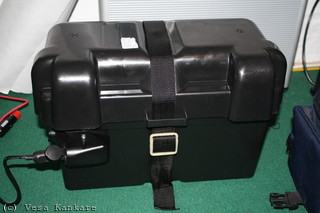Atik Flatfield
12:30 1/3/2009 UTC

I did a flat field image to see how the chip is illuminated by my telescope system and if the camera has any dust in it. Unfortunately I found that there are several dust motes sourcing from the inside of the CCD chamber. Few is in the inside of the window, but the worst (most black spots) are on top of the sensor it self. These are impossible to remove by myself. I had several similar dust specs in my DSLR chip, but I really did not expect them in sealed CCD chamber. 16x1sec @0°C darks applied.
New CCD Camera
18:43 27/2/2009 UTC

Today it finally came, my new CCD camera Atik 4000LE. Of course, not a single chance I could try it out under stars, but I did some quick tests inside to see everything is working and especially HOW everything is working. CCD is completely different game compared to DSLR imaging. Atik is controlled by software called Artemis Capture, which seems to be very nice program for the purpose. I tried Nebulosity2 also. It works, but somehow it messed the cooling of the camera. Artemis Capture is my choice, for a while at least. I did a quick test to expose a 10 minute dark frame at 0°C. After I get hang on the softwares and all other issues I am going to start building a dark frame library - a benefit from regulated cooling. The new battery is also working like charm. I played for like four hours with the camera. Dew heaters, tracing and PC was connected to the battery all the time and no sign of depletion in that time.
Field power
17:38 26/2/2009 UTC

My new camera is completely dependent on computer and as it is cooled it draws more current than DSLR. My previous solution was a 18Ah jump start battery, which is already a in a bad shape. Computer alone eats the battery in half an hour. My goal is I give up before my battery does, so I had to do something. I decided to build a transportable battery using a quality 45Ah AGM battery, which has 45Ah capacity. This battery has enough capacity to power my equipment for 7-9 hours. Only downside is the weight: 14kg.
Moving on
17:29 17/2/2009 UTC

I've been imaging deep sky with DSLR since early 2005 . It has been very interesting time with some ups and downs. After I exchanged my camera to modified one , I really got into imaging using narrowband filters and all. Altough fantastic instruments, DSLR cameras lacks some very important features astronomical CCD cameras have, like cooling and monochrome chip. That's a reason I have sold my DSLR gear and now eagerly waiting something new to pop out from the mail... :P
M42 - The Orion Nebula
21:01 9/1/2009 UTC
Very cold night. I haven't been out imaging in such a cold weather yet. Usually I don't take my gear out if it is below -10°C, but this time I just couldn't stay home. Sky was very transparent and we could easily see stars just few degrees above horizon. Too bad I forgot my SQM home. I was planning to take some 1 minute exposures, but cold had done its magic on my eee battery and I did not have opportunity to fix overexposed core.
NGC/IC Object List:
NGC1976 gaseous nebula RA:05h35m17.1 Dec:-05°23m'25" BMag: 4.0, M 42 Orion Nebula
NGC1982 gaseous nebula RA:05h35m31.3 Dec:-05°16m'03" BMag: 9.0, M 43
NGC1977 open cluster RA:05h35m18.0 Dec:-04°49m'00" BMag: , OCL 525

Camera: Modified Canon EOS 350D | Telescope: Skywatcher ED80 Pro 80mm f7.5 refractor, William Optics 0.8x focal reducer | Mount: Vixen GP-D2, Boxdoerfer PowerFlex MTS-3SLP drive controller | Filters: Astronomik EOS L UV/IR Insert Filter | Guiding: The Imaging Source DMK 21AU04.AS CCD camera, Orion ShortTube 80mm f5 refractor, Stark-Labs PHD Guiding | Exposure: RGB: 6x600s (1h) ISO800 f6, 40 darks, 1 flats, 0 bias | Software: Stark-Labs Nebulosity 2, Adobe Photoshop CS4 | Location: 60°39'N 26°48'E (Huruksela/Kotka, FI) | Image Field: 2.672 x 1.781 degrees | Image Center: Ra 05h34m49s Dec -05°17'42" | Target altitude in the beginning of the exposure 24°